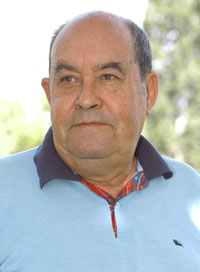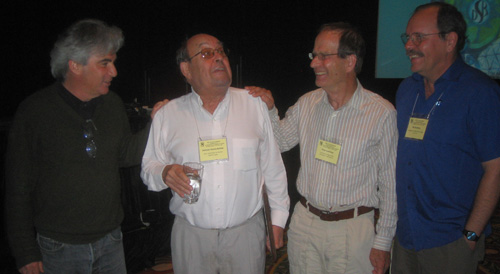Interview with 2012 Developmental
Biology-SDB Lifetime Achievement
Award Winner Antonio García-Bellido
 Antonio García-Bellido
is said to have put Spain on the scientific map.
From his early days, he was interested in
understanding morphogenesis. Using Drosophila,
he focused on how developmental genes act at the
cellular level to control morphogenesis. After
college, he left Spain to work with entomologist,
Vincent Wigglesworth at the University of
Cambridge, and then returned to Spain where he
received his PhD in 1962. He went on to
do postdoctoral work with
Ernst Hadorn at the
University of Zürich, and then
Alfred Sturtevant and
Ed Lewis at the California Institute of
Technology. In the 1970s he again returned to Spain
where he and
Severo Ochoa, established the Center for
Molecular Biology, which has been a premier
institute for the past 30 years. Antonio García-Bellido
is said to have put Spain on the scientific map.
From his early days, he was interested in
understanding morphogenesis. Using Drosophila,
he focused on how developmental genes act at the
cellular level to control morphogenesis. After
college, he left Spain to work with entomologist,
Vincent Wigglesworth at the University of
Cambridge, and then returned to Spain where he
received his PhD in 1962. He went on to
do postdoctoral work with
Ernst Hadorn at the
University of Zürich, and then
Alfred Sturtevant and
Ed Lewis at the California Institute of
Technology. In the 1970s he again returned to Spain
where he and
Severo Ochoa, established the Center for
Molecular Biology, which has been a premier
institute for the past 30 years.
Much of García-Bellido
ground-breaking work came from his use of genetic
mosaics. He was the first to construct a
fate map of the Drosophila embryo through
genetic mosaics. He discovered
developmental compartments or boundaries within
an embryo in which genes control spatial identity.
While controversial at the time, eventually in situ
hybridization revealed stripes of gene expression in
Drosophila blastoderm embryos. He is well
known for his work on homeotic genes in which he
introduced the
concept of upstream 'selector' genes which act
to control downstream 'realizator' (effector) genes
that are responsible for cell behaviors that drive
morphogenesis. His
genetic analysis of the achaete-scute gene complex
provided important clues into how spatial patterns
are built during development.
García-Bellido
received the
Developmental Biology-SDB Lifetime Achievement Award
for his numerous scientific achievements as well as
the impact he has made on the field through
mentoring generations of developmental biologists
who run labs throughout the world. Prior to
the SDB 71st Annual Meeting in July, García-Bellido
was interviewed about his career and receiving this
award.
What has been the most rewarding part of your career up until now?
Certainly, the nomination of Foreign Member of the Royal Society UK. Also, the opportunity of knowing great scientists all over the world and the discovery of splendid students. It is the human component of a scientific career.
Have you had any great mentors in your life, scientific or otherwise?
My father, Ernst Hadorn,
Alfred Sturtevant, and
François Jacob.
My father was a Professor in Classical Archaeology and provided a
humanistic, historicist mentality at home. Alfred Sturtevant
gave me his vision of the origins of genetics,
goals mentality, and scale of values. He had a
historicist mentality as well. Ernst Hadorn was a great “boss”, directing and organizing a very complex Institute. He taught me the necessary finesse directing my group of students. François Jacob was a very sensitive person and imaginative scientist (geneticist) and, in addition, a philosopher of
biology. I learned from him my theoretical inclinations and ambition to deal with complex matters.
What has been your mentoring philosophy over the years?
The search for origins and causes. “Search for origins” is a way of approaching problems, is an attitude in the personal scale of values. “Causes” means analytical ordering of the steps of a process since its beginnings. It includes the categorization of elements with the aim of giving them relevance and meaning.
You have been called the founding father of the Spanish developmental biology community having trained exceptional developmental biologists and influenced scientists throughout the world. How has developmental biology in Spain grown since you started your lab more than forty years ago?
Developmental biology is now a major field in the
basic sciences in Spain.
What does receiving the
Developmental Biology-SDB Lifetime Achievement Award mean to you?
A pleasure because [it is] the manifest recognition of my work by my colleagues.
|
 |
|
Mike Levine, García-Bellido, Peter
Lawrence, and William McGinnis following
the SDB awards ceremony at the 71st SDB
Annual Meeting in Montreal, Canada. |
|